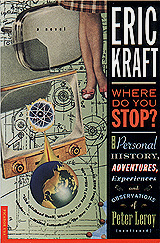

| Where Do You Stop?
Chapter 4: The Mother Lode of Scrap |
by Eric
Kraft, as Peter
Leroy
|

YOU CAN READ THE FIRST THIRD
YOU CAN BUY THE
|
In the course of a few evenings, I produced dozens of sets of plans. The first day’s drawings were of a rather simple tower, something a crew of kids my age might manage to build. The second day’s plans assumed the first day’s and took the project to the edge of the limit of the capabilities of a crew of kids. Everything after that was impossible, but I couldn’t stop. With each succeeding day, the tower grew and became more detailed. It wasn’t just taller—it expanded in every direction. Each version had more rooms, more nooks, more crannies than the last, and before one drawing was even finished I’d thought of things I wanted to add to the next. The idea of the lighthouse was growing faster than I could diagram it, let alone realize it. One afternoon I was in my room comparing the first and the most recent of my drawings and wondering how I had allowed myself to get so carried away, why no calm, quiet inner voice had told me that enough was enough, when I heard footsteps on the stairs. It was the rapid, unmistakable tread of my friend Rodney (Raskol) Lodkochnikov, of the river-dwelling Lodkochnikovs, baymen and boatmen for generations, brother to the two Ernies and the sultry Ariane. Quickly I hid all the drawings but the first. “Hi, Peter,” he said. “What are you up to?” “Oh, just drawing some plans,” I said. “Plans?” he said. He took one look at my drawing and seized it at once. He was impressed. “This is great!” he said. “This is really great.” I’ve never been good at accepting praise. I blush and stammer and look at my feet, just as I did then. “A watchtower,” he said. “Just like those prison movies. Great.” “Um—” “With a searchlight turning on top and everything.” “You—ah—don’t think it looks more like a lighthouse?” I asked. “No!” he said. “Not at all! No, no, don’t worry about that. A watchtower, definitely.” “It looks a little like a lighthouse to me,” I said. “Naaah!” he said, giving me a punch in the shoulder. “Not at all. Don’t worry about it. It’s terrific.” What was I to do? Raskol was my best friend. I looked at the drawings. A transformation seemed to have occurred. It did look like a watchtower. “When do we get started?” asked Raskol. I stalled. “I think the plans need some work before we can start building,” I said. I needed time to make the thing look less like a watchtower and more like a lighthouse. “Really?” said Raskol. “They seem fine to me. I can see the whole thing, plain as day.” That night we began scavenging building materials from the frontiers of the developments, where there was a substantial supply of scrap lumber, bent nails, and remnants of tarpaper. It wasn’t long before we turned to the mother lode of scrap itself: the Purlieu Street School. |
|||

Here are a couple of swell ideas from Eric Kraft's vivacious publicist, Candi Lee Manning: Tip the author.
Add yourself to our e-mailing list.
|
Where Do You Stop? is a work of fiction. The characters, incidents, dialogues, settings, and businesses portrayed in it are products of the author’s imagination and are not to be construed as real. Any resemblance to actual events or persons, living or dead, is entirely coincidental. Copyright © 1992 by Eric Kraft. All rights reserved. No part of this book may be reproduced or transmitted in any form or by any means, electronic or mechanical, including photocopying, recording, or by any information storage and retrieval system, without permission in writing from the author. Where Do You Stop? was first published in hardcover by Crown Publishers, Inc., 201 East 50th Street, New York, New York 10022. Member of the Crown Publishing Group. YOU CAN BUY THE
For information about publication rights outside the U. S. A., audio rights, serial rights, screen rights, and so on, e-mail the author’s imaginary agent, Alec “Nick” Rafter. The illustration at the top of the page is an adaptation of an illustration by Stewart Rouse that first appeared on the cover of the August 1931 issue of Modern Mechanics and Inventions. The boy at the controls of the aerocycle doesn’t particularly resemble Peter Leroy—except, perhaps, for the smile. |
|
||||||
| . | . |